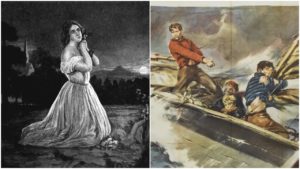
Opera Meets Film: How a Bellini Aria Foreshadows Tragedy in Luchino Visconti’s ‘La Terra Trema’
By David Castronuovo“Opera Meets Film” is a feature dedicated to exploring the way that opera has been employed in cinema. We will select a film section or a film in its entirety and highlight the impact that utilizing the operatic form or sections from an opera can alter our perception of a film that we are viewing. This week’s installment features Visconti’s “La Terra Trema.”
Luchino Visconti’s “La Terra Trema (1948)” is the Italian neorealist film par excellence. Actual Sicilian fishermen, speaking not in standard Italian but in local dialect, play themselves in the tale of a young man who tries and fails to beat the system. The director famously used non-professional “actors” to shoot the story with near-documentary realism.
The protagonist ‘Ntoni, like the other fishermen in his village near Catania, works inordinately hard to bring in his catch. When the fish go to market, however, the local bosses set the prices and take large profits. ‘Ntoni and his family thus remain locked in hopeless poverty.
One day, ‘Ntoni decides to go it alone, and to sell his catch independently at a fair price. The new endeavor fares well at first, and others in the town take heart from ‘Ntoni’s heroic revolt against the bosses.
After a particularly good night’s haul, we see ‘Ntoni surrounded by family members and neighbors: all lend a hand with the freshly taken anchovies, which must be salted before going to market. The scene could not be more joyous. Everyone participates – men, women, old, young – and together they work, joke, and laugh with choral optimism. A dashing local official even stops by to flirt with ‘Ntoni’s sister.
As the scene progresses, however, we gradually become aware that a clarinet is playing dolefully in the background. At first, it’s not certain if the melancholy music we hear is diegetic or not. We recognize the tune as “Ah non credea mirarti” from Vincenzo Bellini’s “La Sonnambula,” but only at scene’s end do we discover that it’s an old man, sitting outside the house, who has been playing the aria on a clarinet. Even the local official recognizes Bellini’s music, and utters words of praise both for the composer and for the old man’s playing.
“Ah non credea mirarti” seems at first an incongruous and cheerless choice on Visconti’s part. In “La Sonnambula,” it expresses appropriately the incredulous despair of a lover gone mad with disappointment; in this scene from “La Terra Trema,” however, it disturbs and contrasts with the hopeful nature of the events taking place inside ‘Ntoni’s home.
One may ignore at first the incongruity of Visconti’s choice, and interpret the use of the aria as a straightforward homage to Bellini, who was himself from Catania. But the director is giving us more than local color: rather, he is hinting at the action to come.
Not long after we witness the happy scene of the anchovies, everything will change. An overnight storm will wreck ‘Ntoni’s boat, and dash forever any prospect that he’ll break free of the bosses’ grip. We realize only then, in retrospect, that Visconti has used the heartbreaking melody from “La Sonnambula” to foreshadow the tragedy that will befall ‘Ntoni. The aria is particularly appropriate because after he suffers the loss of his boat, the young fisherman – like the heroine of Bellini’s opera – will almost go mad.
It is as though the old clarinetist, isolated physically and spiritually from the others, possesses a wisdom as ancient as the town itself: he alone knows what’s in store for ‘Ntoni. Against the backdrop of everyone else’s joy, his rendition of “Ah non credea mirarti” is a sign that from the start, fate has doomed ‘Ntoni’s valiant efforts. The poor can never beat the system.
“Ah non credea amarti” is Bellini at his best: this is the melodist for whom even Richard Wagner expressed profound admiration. The text of the aria’s first section (in A minor) centers on the image of a flower that withers, like love, in the space of just one day:
“Passasti al par d’amore
Che un giorno sol durò.”
Bellini develops the aria’s long andante phrases so as to avoid symmetrical repetition; triplets and melismas linger on words symbolic of hope’s brevity, even as the melody drifts steadily and inexorably toward a sense of inescapable despair.
In a second section, the aria moves into C major, and achieves a certain note of calm resignation; Visconti downplays this movement in “La Terra Trema,” however, by changing the structure of the aria as heard in the opera. He has the old clarinetist play the aria’s first (minor) section twice, thus giving the second (major) section short shrift. This restructuring emphasizes the first section’s weightier feeling of hopelessness, and strengthens the foreshadowing of ‘Ntoni’s downfall.
One suspects that Visconti’s decision to use an aria from “La Sonnambula” in “The Earth Trembles” springs from the fact that both opera and film share a strong choral element. Both are set in small villages, where the protagonists’ fortunes inevitably affect the harmony and balance of the community as a whole.
Seven years after the film’s release, Visconti would again turn his attention to “La Sonnambula,” and direct a landmark staging of the opera at Milan’s La Scala (with Maria Callas in the title role, and Leonard Bernstein at the podium).
Categories
Opera Meets Film

